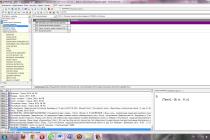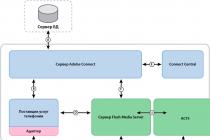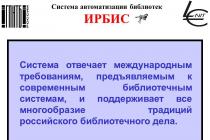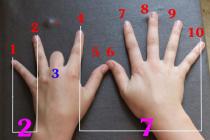It is not always necessary to carry out measurements only to correctly connect the measuring device. It is very important to answer the question: why am I measuring this? To measure the current when checking the heat release in the wire, one parameter is required, to measure the current to determine the charge level of a capacitor or battery - quite another.
Parameters can be expressed as mean, rms ( RMS, Root Mean Square), instantaneous or peak value. Not only the type of load is important, but also whether we are dealing with alternating or direct current and what the shape of the voltage and current looks like. Closely related to the concepts of voltage and current are power and energy.
Instantaneous values
Instantaneous current, voltage and power are values that correspond to a particular moment in time. Any signal consists of an infinite number of instantaneous values. In the case of voltage, this is written as.
Consider a circuit consisting of a series-connected resistor and inductor connected to a sinusoidal voltage source with peak voltage and frequency Hz.
Sinusoidal voltage as a function of time, in this case, can be written as:
(1)
The current has a maximum value and is shifted in relation to the voltage:
(2)
Power, as a function of time, is the corresponding instantaneous voltage and current values:
(3)
The figure below shows graphs of voltage, current and power.
For example, the gray line shows instantaneous values for a point in time ms:
v (4.2) = 2.906 V
i (4.2) = 0.538 A
p (4.2) = 1.563 W
At a given point in time, the instantaneous voltage and current can always be multiplied by calculating the instantaneous power.

Average values
Average values are the most commonly used parameters.
If the multimeter is set up to measure DC values, the average voltage and current are measured. In addition, if the multimeter is operating in dc measurement mode, it will also measure the average voltage or current for ac signals. In the case of symmetrical alternating voltage, the multimeter will show which is the correct value.
Voltage and current
The average is the sum of all products of instantaneous values divided by the number of measurements taken. If measurements are made an infinite number of times, then we can go to the limit in which the measurement time interval → 0 and the sum turns into an integral. In general:
(4)

For voltage, we get:
(5)

Multimeter
As mentioned earlier, the multimeter, when set to DC measurement, measures the average value of the voltage or current. In digital instruments, this average is obtained using RC-filter. The input signal is continuously averaged over a time constant. As a formula:
(6)


Voltage averaging by RC filter
Energy and power
Equation (3) shows that the product of instantaneous voltage and current results in instantaneous power. If you add up the instantaneous power multiplied by the infinitesimal time, the result is energy. Because :
(7)

Indeed, energy is power multiplied by time: and energy packets can always be added to calculate the total energy.
As an example, again, let's take a series connection of an inductor and a resistor. In the figure below, the black line shows the dynamics of energy over time, calculated in accordance with equation (7).

The power curve in the case of voltage and current of alternating polarity, also has a periodic amplitude change with twice the frequency. Since the energy is dissipated in the resistance, the gray area of the positive values of the power curve is larger than the negative area.
The energy value (black line) at any point in time is equal to the area under the power curve up to that point. It is clearly seen that the energy periodically increases more strongly than it decreases as a result of the amplitude asymmetry of the power curve about the axis.
The figure shows the time period. The energy within this time interval, which entered the system, is indicated and calculated as follows:
(8)

The average power over a certain period of time is equal to the total amount of energy during this time divided by the measurement time:
(9)
If this is substituted into equation (8), the average power can be calculated for any.
(10)

This equation was obtained in accordance with (4). The active power is always the average power.
This equation for calculating the average power dissipation is always valid because the calculation is based on instantaneous values. It doesn't matter if the current is DC or AC, what the voltage and current waveform looks like, and whether there is a phase shift between voltage and current.
The equation for calculating the average power is at the heart of the method used in power meters. Electricity meters at home and in enterprises operate in accordance with equation (8), which can be rewritten as:
(11)

The upper limit in the integral is the point in time at which the energy meter reads the value.
Effective ( RMS) values
RMS ( RMS), or the effective value is the voltage or current value at which the load dissipates the same power as at constant voltage or current.
With alternating voltage with an effective value 230V the same amount of heat will be generated at the load as at constant voltage 230V... The r.m.s. value applies only to heat dissipation in the resistive load. For example, the value RMS current is useful for measuring voltage under load in a wire (= resistive), but not to measure the charging current of a battery or capacitor (= electron flow).
Averagesquare value
RMS is an abbreviation for Root Mean Square, which literally translates to root mean square value.
Over voltage or current as functions of time to calculate the value RMS three mathematical operations are carried out sequentially: squaring, averaging, and square root extraction. Why is that?
Power dissipated across a resistor connected to a voltage source:
(12)
For instantaneous power and voltage:
(13)
The calculation of the average power as a function of time is shown in (10). we can find from (13):
(14)

Since is a constant, it can be taken out as an integral:
(15)

By moving the voltage in equation (12) to the left side, we can calculate the voltage from the average power and resistance:
(16)
Then, we substitute the calculated average power from (15) into equation (16):
(17)

Reducing the resistance values, we get:
(18)

It is clearly seen that this equation consists of three parts: square, mean and square root.
In the above calculations, the value of the voltage across the resistor was calculated. The same can be done for the current through the resistor:
(19)

Most multimeters cannot calculate the effective value of the measured voltage. To find out the RMS value, a special instrument is usually needed.
The figure below shows how the instrument calculates the measured voltage. True RMS(true rms values). True RMS the device, in practice, uses a slightly different method of operation, in which only one multiplier is needed. Analog multipliers must have very low temperature drift and offset, which makes these instruments quite expensive.

Analog circuit for obtaining RMS values
In addition, you can make a calculation RMS programmatically from sequential digital values of the measured voltages. This approach is commonly used in multimeters and.
Pseudo RMS
Most multimeters do not measure RMS-values when AC mode is selected. However, they seem to give effective values when measuring alternating voltages and currents. However, the displayed values are only valid when measuring a sinusoidal signal.
A simple instrument first straightens the signal to be measured. Then RC- A low-pass filter highlights the average value, which is scaled so that the meter shows the effective value. As an equation:
(20)

The disadvantage of this approach is that it is only suitable for sinusoidal signals. For any other waveform, an erroneous effective value will be obtained.
Rated power?
Especially in audio technology, the term "rated power" or is widely used. This is a misnomer by definition.
Slightly above, speaking about energy and power, it is shown that the working power is calculated from the total amount of energy divided by the time for which this energy is measured, see equation (9). The total energy is determined by summing all instantaneous energy packets, see equation (11). This is the only correct way to calculate active power.
As indicated above, the effective value is equivalent to a constant voltage or current that will deliver the same power at the same resistance. This indicator is calculated as the square root of the mean of the square of the instantaneous voltage (or current). There is no reason to think that these three mathematical operations should be performed for instantaneous power. It would be meaningless.
Alternating voltages and currents can be characterized by different indicators. For example, for alternating periodic voltage freeform u(t), in addition to the amplitude values, it can be characterized by:
- average(constant component)
- rectified mean

- effective or effective value

Most often, the action of an alternating voltage or current is judged by the average power over the period that heats up the active resistance R through which an alternating current flows (or to which an alternating voltage is applied). The heating process is inertial and usually its time is much longer than the period T alternating voltage or current. In this regard, it is customary to use the effective value of the sinusoidal voltage and current. In this case:
Hence, it is clear that to measure the effective value of a sinusoidal voltage or current, it is enough to measure their amplitude value and divide by √2 = 1.414 (or multiply by 0.707).
AC voltmeters and ammeters are often used to measure AC voltage and current levels. non-sinusoidal... Theoretically, such signals can be represented by a Fourier series, consisting of the sum of the constant component of the signal, its first harmonic and the sum of the higher harmonics. For linear circuits, due to the principle of superposition, the power of a non-sinusoidal signal is determined by the power of all its components. It depends on the harmonic composition of the signal, which is determined by the waveform.
As a rule, regardless of the measurement method, they are usually calibrated to the rms sinusoidal AC voltage or current. Usually, in this case, using a full-wave rectifier, the voltage or currents are rectified and it is possible to measure their average rectified voltage (it is often called simply average, but this is not entirely accurate - see above). The deviation of the form of an alternating voltage from a sinusoidal one is taken into account by the form factor:
k f =U d / U wed
For a square wave (meander) kФ = 1, and for sinusoidal kФ = π / 2√2 = 1.1107. This difference causes a large difference in readings even in these simple cases.
Nowadays they are widely used personal computers, Cell Phones with pulsed operation of transmitters, pulse and resonant voltage converters and power supplies, variable speed drives and other equipment consuming currents in the form of short-term pulses or sections of a sinusoid. In this case, the root-mean-square value of the signals should take into account all the harmonics of its spectrum. In this case, it is said that it is true rms (TrueRMS or TRMS).
Unfortunately, when measuring voltages and currents with different, other than sinusoidal, time dependences, great problems arise due to the violation of the relationship between the average rectified or amplitude values of an alternating voltage or current and their effective values. Conventional voltage and current meters with averaged readings in this case give an unacceptably large error, see Fig. A simplified measurement of the effective value of currents can sometimes give an underestimation of up to 50% of the true results.

Rice. 1. Comparison of different types of measurement of varying voltages and currents
A user who does not know this may wonder for a long time why a fuse in a 10 A device regularly burns out, although according to the readings of an ammeter or a conventional multimeter, the current is 10 A. When the measured voltage or current curve deviates from the ideal sinusoidal shape, refinement using a factor of 1 , 1107≈1.1 becomes invalid. For this reason, meters with averaged readings often give incorrect results when measuring currents in modern power networks... In this regard, devices were created that measure the truly true rms value of an alternating voltage and current of any form, which is determined by the heating of a linear resistor connected to the measured voltage.
Modern multimeters measuring AC voltage or current (not necessarily sinusoidal) today are usually labeled with a True RMS label. In such meters, more advanced measurement schemes are used, often with microprocessor control and correction means. This made it possible to significantly increase the measurement accuracy and reduce the dimensions and weight of the devices.
Accurate measurements are a difficult task facing technologists and service specialists of modern production facilities and equipment of various organizations. Our daily life more and more includes personal computers, variable speed drives and other equipment with non-sinusoidal characteristics of current consumption and operating voltage (in the form of short-term pulses, with distortions, etc.). Such equipment can cause inadequate readings on conventional averaging meters (which calculate the rms value).
Why Choose True-RMS Instruments?
When we talk about AC values, we usually mean the mean effective heat dissipation or the root mean square (RMS) value of the current. This value is equivalent to a DC current that would produce the same thermal effect as the AC being measured and is calculated using the following formula:
 .
.
However, when the sinusoidal curve deviates from the ideal shape, this coefficient ceases to act. For this reason, averaging meters often give incorrect results when measuring currents in modern power networks.
Linear and non-linear loads


Rice. 1. Curves of voltage of sinusoidal and distorted form.
Linear loads, which include only resistors, coils and capacitors, are characterized by a sinusoidal current curve, so there are no problems when measuring their parameters. However, in the case of non-linear loads, such as variable frequency drives and power supplies for office equipment, distorted curves occur in the presence of interference from high-power loads.

Rice. 2. Curves of current and voltage of the power supply unit of a personal computer.
Measurement of the rms currents from such distorted curves using conventional meters can give, depending on the nature of the load, a significant underestimation of the true results:
|
Device class | Load type / curve shape
|
|||
| PWM (meander) | single phase diode rectifier | three-phase diode rectifier |
||
| RMS | correctly | overestimation by 10% | understatement by 40% | underestimation of 5% ... 30% |
| True RMS | correctly | correctly | correctly | correctly |
Therefore, users of ordinary devices will have a question why, for example, a 14-amp fuse regularly blows, although according to the ammeter the current is only 10 A.
True RMS (True RMS) Instruments
To measure current with distorted curves, it is necessary to check the shape of the sinusoid using a signal curve analyzer, and then use a meter with averaging readings only if the curve turns out to be a truly ideal sinusoid. However, it is much more convenient to use a True RMS meter all the time and always be confident in your measurements. Modern multimeters and current clamps of this class use advanced measurement technologies to determine the real rms values of AC current, regardless of whether the current curve is a perfect sine wave or is distorted. For this, special converters are used, which determine the main difference in cost with budget counterparts. The only limitation is that the curve must be within the acceptable measuring range of the instrument used.
Everything that concerns the features of measuring non-linear load currents is also true for measuring voltages. Voltage curves are also often not perfect sinusoids, resulting in averaging meters giving incorrect results.
Based on the examples described above, in modern high-tech electrical systems for measuring currents and voltages, it is recommended to use devices of the True RMS class.
The AC wattmeter presented in the article allows you to measure the following parameters:
1. RMS voltage
2.
RMS current
3. Active power
4. Full power
5.
Power factor
6. Average load power (see below)
Possibilities and features of this implementation:
1. The measured power range is divided into two ranges to improve accuracy, and switching between them occurs automatically.
2. To improve readability and simplify the taking of readings, two options for displaying information are implemented (in the photo below)
3. The device allows you to determine the output of voltage and current beyond the established limits and control the load based on this information.
4. The device also measures the power over the period, so you can determine the real consumption of devices with variable power (refrigerator, iron, computer).
Photo
Active power. Current. Voltage.
The same is the Gross Power. Power factor. Average power over the measurement period.

Measurement technique:
There is an excellent article by Oleg Artamonov http://www.fcenter.ru/online.shtml?articles/hardware/tower/6484
It is in accordance with it (and with the theory) that the program is built.
Scheme :
Built with readily available components and easy to repeat.

PSU - any 5V power supply with small ripple.
Amplifier - LM2904 or similar
Trimmers P1 and P2 - multi-turn
The shunt Rsh is assembled from 0.1 Ohm 2W resistors connected in parallel. Selected on the basis of approximately 1 resistor per 1 kW of maximum measured power. There is space for 10pcs on the board. I have 4 installed, about 4 kW.
The ATMega8 is configured to run from an internal generator, 8MHz.
Appearance :
Pay attention to the optocoupler in the left upper corner.

Printed circuit board:

Please note: not all elements printed circuit board used. V current version there is no need for quartz with its strapping, button K2 (next to K1, not marked).
An opto-isolator is located in the right corner, but I recommend making it as a separate device. It will come in handy.
Setting up and operating the circuit:
Attention: the diagram is under mains voltage... Perform the firmware of the MK with the voltage off, power it through the programmer! Connect the UART output only via opto-coupler!
The setup is divided into two stages.
Step 1. Zero point adjustment.
Press the button and turn on the device. Release the button.
An image of the following type will appear on the screen:

These are voltage and current values on a scale of 0..1023.
From left to right: period minimum, period maximum, average.
Using the trimmers P1 and P2, set the average to 511.
We check the presence of a stock above and below the minimum and maximum.
The number after the # indicates the number of samples taken in the period. This number should be slightly less than 200.
Stage 2. Calibration.
Connect the UART-USB adapter. For example like this:

through opto-decoupling. Its board is in the file along with the main board, on the next tab.
Run the terminal program at 4800 speed.
- Connect an exemplary voltmeter and ammeter and an active load, for example 100W.
- Connect the device to the network. During loading, on the image of the "thermometer", hold down K1 and do not release it until the "thermometer" reaches the edge of the screen. (Setup) appears on the screen.
- An image of the following should appear in the terminal:

This is a dialog box. The new value is saved as follows:
(item) (Enter) (value) (Enter)
Explanation of points:
1, Constant for voltage
2.
Constant for current 1 range
3. Constant for current range 2
4. Number of measurement periods. Affects the frequency of information updates.
5,6,7 Installations for load control (fuse). Control outputs LED1, LED2.
8. Controlling output to the terminal. See below.
0. Exit
To calibrate, make up the proportion of the form: X = (recorded constant) * (reference voltage) / (displayed voltage)
Write to memory. Repeat if necessary.
Repeat for current, then change the load to get into the second range (say 1000W) and repeat again.
Everything, you can use it.
Other:
1. An indicator is located in the upper right corner. Its blinking confirms the operability of the device.
The dot inside this indicator shows the included range: less - 1 range, more - 2 range.
2. Constant Disp, described in the second stage of calibration, controls the mode of data output to the terminal.
Disp = 0 Nothing is displayed.
Disp = 1 Duplicate display data to terminal:

Disp = 2 "Oscilloscope" mode. In this mode, the saved measurement data of instantaneous voltage and current values are output to the terminal, where they can be copied (for example) into Excel, checked for adequacy, and simply used to study the current and voltage waveforms in the network. A sample file is attached to the article.

4. In operating mode, the K1 key switches between display modes.
That's all. I would be glad to hear from you.

List of radioelements
| Designation | Type of | Denomination | Quantity | Note | Shop | My notebook | |
|---|---|---|---|---|---|---|---|
| BP | Power Supply | 5 volts | 1 | Any | Into notepad | ||
| USB-UART adapter | 1 | Required for calibration | Into notepad | ||||
| Optical isolation board | 1 | In the photo, for a USB-UART adapter | Into notepad | ||||
| OP1, OP2 | Operational amplifier | LM2904 | 1 | Into notepad | |||
| IC2 | MK AVR 8-bit | ATmega8 | 1 | Into notepad | |||
| LCD display | HD44780 2x20 | 1 | Into notepad | ||||
| D1, D2 | Rectifier diode | 1N4007 | 2 | Into notepad | |||
| LED1, LED2 | Light-emitting diode | 2 | Into notepad | ||||
| C1, C2 | Electrolytic capacitor | 6.8 uF | 2 | Into notepad | |||
| C3 | Capacitor | 100 nF | 1 | Into notepad | |||
| R1 | Resistor | 20 kΩ | 1 | Into notepad | |||
| R2, R5, R8 | Resistor | 10 kΩ | 3 | Into notepad | |||
| R3, R6, R10, R13, R14 | Resistor | 1 kΩ | 5 | Into notepad | |||
| R4 | Resistor | 470 k Ohm | 1 | Into notepad | |||
| R7 | Resistor | 0.1 ohm 2W | 10 | Rsh, connected in parallel, select quantity | Into notepad | ||
| R9, R12 | Resistor | 680 Ohm | 2 | Into notepad | |||
| R11 | Resistor | 330 k Ohm | 1 | Into notepad | |||
| P1 | Trimmer resistor | 330 k Ohm | 1 | Multi-turn | Into notepad | ||
| P2 | Trimmer resistor | 1.5 k Ohm | 1 | Multi-turn | |||
Two years ago I reviewed this multimeter model. It was a device ordered at the request of a friend of mine. This time I ordered it on my own (I counted on it as a gift). I received the order in the spring. But, I think, the review has not lost its relevance. So what made me do this review? In that topic, I made one serious omission. I did not notice the True RMS inscription at all. I also missed some measurements. I'll check in more depth.
And it would not hurt to remind you that there is such an inexpensive multimeter (the cheapest with True RMS). After all, not everyone has read that review.
I used a discount to buy a multimeter. If you have points, you can use them too.
First, let's take a quick look at how everything arrived. The package is trackless. I really didn't want to pay for the track, knowing especially that everything comes pretty well from this store (less than 30 days from payment). 
Standard package without a "bubble". Inside, the polyethylene foam was supposed to protect the device from all surprises. 
He did not protect against all surprises. As a result, we have a seriously flattened box. But the device is safe and sound.
Here's what was included:
1-Box
2-Multimeter
3-Instruction in the "native" Chinese language. The scan can be viewed here:
4-Two AAA batteries (inside the multimeter).
5-Lace on ……. hand? More like two fingers (well, very small).
6-Warranty card. 
During this time, nothing has changed in the design of the device. 
Holographic sticker confirming authenticity (hieroglyphs in the center and its perimeter). 
I open the lid and the device is ready for use. Probes with wires are neatly collected in a special pocket. Length of wires 37cm + probes 10cm. There is very little space. With difficulty, everything fits. 
The wires are thin and not soft. If you throw it in the car and use it occasionally, it will be enough for a long time. The probes will soon need to be replaced with daily use. New ones will not fit into the pocket. You will have to drill a hole (hole) on the side. Otherwise, the lid will not close.
I did not notice this inscription then. 
On the lid brief characteristics with the capabilities of the device. 
On the store page for more details, indicating the measurement error. 
In fact, everything is much better. More on this later.
The device itself is in a plastic case with a cover that covers the front panel. The body is neatly made, everything fits snugly enough.
Small multimeter. 
Weighed it. With batteries 127g. 
The inscriptions on the device are clear-cut. 
The lid has a latch, it closes tightly, you need to make a little effort to open it. There is a slot in the lid. You can only close the device with a lid if the mode switch is set to the correct left “off” position. 
The cover can be used as a stand. Although, such use is questionable. 
The operating mode switch is disk, with a clear fixation and a click.
When turned on, the mode with automatic selection of the measuring range is automatically turned on. There is a yellow "RANGE" button for manual range selection, with cyclic switching.
There is no display backlight.
Auto-off.
If no operations are performed with the device using the rotary switch or buttons, then after 14-15 minutes it will give four short warning beeps (loud enough). After the fifth longer time, the multimeter goes into sleep mode and turns off. To revive it, you will have to turn the mode switch to the OFF position, and then turn it on to the desired position. It does not react to pressing the buttons, it will not be possible to "revive" this way.
Enabling / disabling the "RANGE" automatic measurements mode (yellow button).
Works when measuring AC / DC resistance and voltage. To do this, click on the button. A short press switches the sub-bands. In the mode of measuring capacity and frequency auto mode measurement does not turn off.
Relative measurements "REL" (blue button).
Works when measuring voltage and resistance.
When measuring frequency, switches to duty cycle measurement mode.
Display resolution: 4000 readings with floating point.

The display capabilities are redundant in relation to the capabilities of the device.
The device is powered by two AAA batteries. This is undoubtedly a plus. 
Batteries were included. Ordinary saline, it is better to change them. If they flow, the springs will spoil.
Who cares, let's take a look at what's inside.
I unscrewed one self-tapping screw. Without removing the battery cover, you cannot get to the "giblets". Next, you need to neutralize several latches. 
Then I unscrew 4 screws. 
The contact pads of the switch are barely greased. Lubricated with ciatim.
There is not a single trimmer inside. On the one hand, it's bad. It is impossible to adjust the measurement accuracy (in which case). On the other hand, good. There are no trimmers, which means there is nothing to go astray.
In the role of the processor, a microcircuit of the "blob" type. They did not regret the compound. 
I have no comments on the quality of the soldering.
I close the device and proceed to determining the accuracy of the device.
All devices, with which I will determine the accuracy, have a cost in the range from 10,000 to 100,000 rubles. Naturally, these are not personal devices. Hardly anyone has them for personal use. Someone will be interested.
Let's check how the change is measured using B1-9 (installation for checking voltmeters) 
This setting allows you to measure the error directly as a percentage. But I won't use this convenient option. I will give all measurements in the form of a table. In my opinion, this is clearer. I set the frequency to 50Hz, bring the error regulator to zero. I just write down what the multimeter shows. 
The result is simply gorgeous. You can not pay much attention to 10mV. Firstly, the error gives the voltage induced on the wires (pickup). Secondly, in my entire life it was not necessary to measure voltages of such a level. To measure voltages of this level, shielded wires of short length are required.
Among other things, this setting allows you to change the frequency of the reference signal. As a result, I got that the multimeter allows you to accurately measure a sinusoid within 10-1100Hz.
And here is a comparative photo of the measured voltage of an industrial network with another fairly accurate device True RMS V7-78 (we will consider it exemplary), which costs once… more expensive than the monitored one. 
There are discrepancies. But this is a very good result. Believe me, I have been working for several years ...
The constant will be evaluated using the programmable P320 calibrator. It's simple. I connect a multimeter to the calibrator and write down what it (the multimeter) shows. All data was put into a table. 
At 420mV - 4.2V - 42V, the result is simply gorgeous. On the rest - within the declared boundaries.
Let's move on to measuring resistance.
Resistance stores P4834 and P4002 will help me.
First I bridged the probes. 
All measurement data are summarized in a table. 
If you do not take into account the 42MΩ limit, the error is much higher than the declared one (in the last digit).
Diode ringing and buzzer are separated in different modes... When the diodes are ringing, the battery voltage is present on the open probes. You can ring the LEDs. Under load, the voltage (naturally) drops. 
In the buzzer mode and measuring the resistances, the voltage across the probes is about one Volt.
These are actually measured readings.
I will check the accuracy of measuring the containers using the P5025 magazine.
I will explain some of the nuances.
1.The sample has an initial capacity, it must be taken into account.
2. When measuring capacities over 10μF, a delay in measurements is observed. I noted the delay time in the table. 
The store is limited to a capacity of 100μF. I do not have a sample for a larger capacity.
I will add a few photos with measurements of electrolytes. 
I wanted to know what limit the device is designed for. But I never found out. 
The specifications say that it can measure up to 200μF. As you can see from the photo, it can measure more than 10.000μF. Nice feature!
The device measured this bundle in 7 seconds. Although, according to the logic of testing on a sample, I thought that he would spend at least a minute.
Frequency measurement ...
To determine the measurement accuracy, I connected the Will "TEK Stabilock 4032 to the device. I did not strain myself. The device can give out calibrated frequencies, which is very convenient. 
I apologize for the quality of the photo. The device is in the corner of the room. And with a flash, the picture quality is even worse.
All data was put into a table. (The frequency sensitivity of the device was duplicated on G3-112.)
The accuracy of the readings is clearly higher than stated. 
Measures the frequency above 10 MHz. True, the sensitivity is rather weak. We have to turn up the signal. Stopped at 34MHz. 
We return to the beginning of the review. So what made me do this review? In that topic, I made one serious omission. I did not notice the True RMS inscription at all. A distinctive feature of this multimeter is the calculation of the rms value of the measured AC voltage.
Checked with MHS-5200A. Interesting in that it can generate signals of any shape. I set the frequency to 50Hz. But there is a peculiarity. Shows only the signal swing (in my case, 10V peak value). 
The waveform and the root mean square (True RMS) value were controlled using another device (who knows the price - keep quiet :))
First filed a sine wave. 
Then he filed like this.

Then this one.

Then this one. 
And finally ... 
Super!
Conventional multimeters (give an error of more than 8%) on such waveforms start to lie a lot. 
I calibrated this device (FUYI FY9805) specifically for reviews, I like it for its contrast of numbers. But you can't insert True RMS into it: (Therefore, it is lying, if not a sinusoid.
And VICTOR VC921 did not disappoint. The Chinese did not cheat. He really can.
It's time to move on to the final part. I will highlight what I liked and did not like. The point of view is subjective.
Minuses:
- You cannot quickly replace the probes (in case of breakage), since they are soldered directly into the device board.
- Small space for probes.
- Paley testimony, in contrast to their fellows.
- Does not measure current strength (for some, this is important).
- There is no analogue scale.
- No display backlight.
- Not soft, average quality probes.
Pros:
+ The indicator shows the measured values (μF, mV, ...).
+ Autoselection of measurement limits (with the ability to disable the function).
+ Made neatly and soundly.
+ You can ring the LEDs.
+ The presence of auto shutdown. The device will turn off after 15 minutes.
+ The device (from the point of view of metrology) is simply gorgeous. True, there are some nuances.
+ Powered by two AAA elements is a definite plus (for me). I will find it always and everywhere (even on a business trip, even at home)
+ The presence of a slot for a switch on the front cover forces the device to be turned off after use.
+ Measures electrolytes with a capacity of over 10,000 μF!
+ With True RMS!
Output:
It's really worth it. Apply the coupon and you will be happy too :)
It seems everything. If you forgot something, correct it.
How to properly dispose of the information from my review, everyone decides for himself. I can only guarantee the veracity of my measurements. If you are unclear about something, ask questions. I hope at least helped someone.
That's it.
Good luck everyone!














